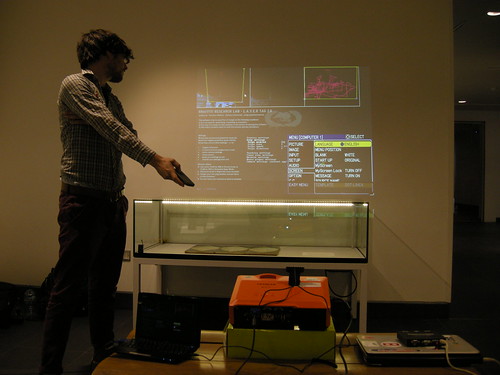Inkvisible #1: Getting to know the medium
Last month I was invited to take part in in Arts and the Digital Ideas Lab (part of King’s Cultural Institute’s Creative Futures programme, produced in collaboration with Caper) as a creative technologist.
About 40 people took part – split more-or-less evenly split between representatives of academia (primarily King’s College London), cultural organisations (such as the Maritime Museum, Coney, Crafts Council and the Royal Shakespeare Company) and the creative technologists (always a delightfully ‘misc’ collection).

At a previous event 19 challenges had been arrived at and we started off by aligning ourselves to one of these. I gravitated towards “How can we nurture and sustain spaces for collective creative and critical thought in the digital world?”.
By the end of the day I was on a team pitching an idea that we later wrote up as:
Inkvisible is a hybrid framework of digital, projected graffiti; game mechanics; and narrative applied within the interior space of the museum.
Our aim for this phase of the project is to playtest different variations of the framework at Birmingham Museum and Art Gallery (BMAG) in order to gain an understanding of how it can be applied to create a channel through which the audience’s critical voice can be expressed and heard.
We got some money; we got the go-ahead from BMAG and now we’re doing it!
Starting yesterday, we began what’s effectively a 4-day residency to get to grips with what the affordances of this idea might be.
‘We’ now being a team consisting of:
- Me (project lead)
- Dr Gretchen Larson (our King’s academic)
- Linda Spurdle (Digital Manager and our host at BMAG)
- Ben Eaton (A member of Invisible Flock and our main techy person)
(Others also contributed to the development of the initial idea.)
So, our first task was to get to grips with the technology we would be using to project the graffiti. We’d short-listed the Graffiti Research Lab’s L.A.S.E.R. Tag system (which seemed very much in the spirit of the voices we’re trying to encourage and the brief to use open source software as much as possible) and an alternative using motion sensing via a Kinect and outputting with Processing.
Ben and I set up in Gallery 10 and started experimenting…
We had a bit if hoo-hah caused by insufficient cable-age and interference from the display cabinet lights, but before too long we were up and running and attracting curious observers.
It was immediately obvious that this was something that draws people (of all ages) in and can be used as a catalyst for conversation. Our task next is to make those conversations productive. We’ll be exploring that more when Dr Larsen and I are back in the museum again on Tuesday and Thursday next week.
For the remainder of yesterday’s experiments, we tried a few more locations.
Our attempts at projecting down from the balcony into the Buddha Gallery were thwarted by what we think was a combination of distance, reflection angles and the background orange light.
Next we tried the iconic Round Room – the first bit of the collection you encounter as you come in from the main entrance.
Wanting to cover an area that overlapped with several paintings, we struggled again due to angles of incidence and the matt paint on the walls preventing the laser spot from being detected. We’ve been given permission by the conservation team to use our lasers on certain materials (not egg tempera, textiles or watercolours), but we don’t really want to upgrade to using a more powerful laser (we’re currently using Class 2).
So, out of a combination of necessity and curiosity, we then tried honing in on one single painting.
As you can imagine, this had a very different feel compared to when we were using a blank area of wall above the cabinet in the ceramics gallery.
Having a specific and almost-tangible object to interact with (you really get a sense of the (im)materiality of both the pigment and the overlaid light when you’re up close) gives the opportunity to respond to something in particular.
We had people telling us about what they thought of the painting, for example: having grown up in that area of Oxfordshire and how the landscape reminds them of home. We also had someone backing-off to sit down and think for a bit before returning and asking to write the word ‘sky’ – the element that struck her the most.
The location in this part of the museum was very well trafficked and we had an almost constant stream of people coming up to us to ask questions, share their thoughts and give it a go.
People’s responses were not always positive – which I think is fair enough – and these were also important conversations to have. A few people said they didn’t see the point and one man in particular felt that we were being quite disrespectful to the work of the artist.
That last conversation came towards the end of the day when the overlaid projections were getting quite scribbly and doodley. Our experiments also came the day after a portrait of the Queen was defaced with real spray paint.
It seems that use of the laser pen and seeing the resulting ‘paint’ traces is experience enough, and we’re not sure how much narrative we want – or need – to wrap it up in. What I think we will have to focus our efforts on is how to steer the use of this tool towards eliciting comment on the institution.
We’re in again playtesting on Tuesday and Thursday next week (18th and 20th of June) – do pop in and join the experiment.










